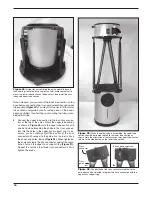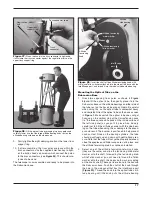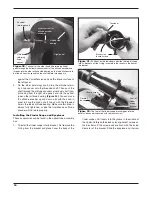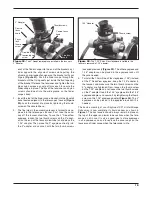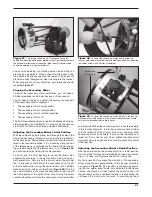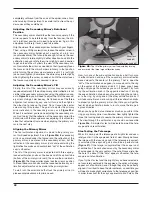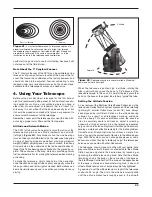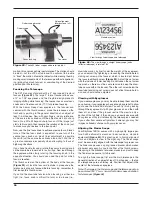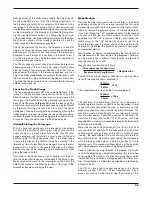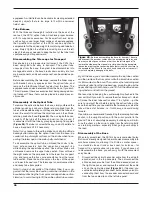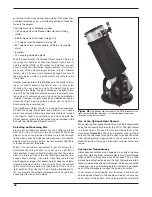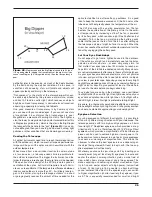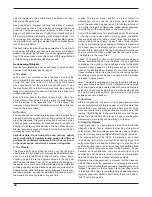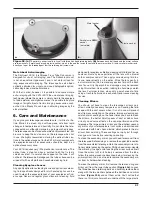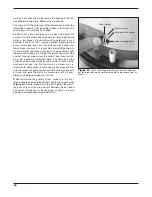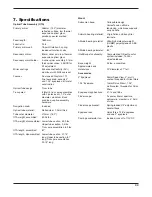
30
objects like planets and double stars. The Moon also takes
higher magnifications well.
Deep sky objects, however, typically look better at medium
or low magnifications. This is because many of them are
quite faint, yet have some extent (apparent width). Deep sky
objects will often disappear at higher magnifications, since
greater magnification inherently yields dimmer images. This
is not the case for all deep sky objects, however. Many galax-
ies are quite small, yet are somewhat bright, so higher power
may show more detail.
The best rule of thumb with eyepiece selection is to start with
a low power, wide field, and then work your way up in magnifi-
cation. If the object looks better, try an even higher magnifica-
tion. If the object looks worse, then back off the magnification
a little by using a longer focal length eyepiece.
astronomical Objects
Now that your telescope is set up and ready to go, one critical
decision must be made: what to look at?
A. The Moon
With is rocky and cratered surface, the Moon is one of the
most interesting and easy subjects to view with your tele-
scope. The best time to view it is during its partial phases
when shadows fall on the craters and canyon walls to give
them definition. While the full moon may look like a tempting
target, it is not optimal for viewing. The light is too bright and
surface definition is low.
Even at partial phases the Moon is very bright. Use of an
optional Moon filter helps to dim the glare. It simply threads
onto the bottom of the eyepiece. You’ll find the Moon filter
improves viewing comfort, and helps bring out the subtle fea-
tures on the lunar surface.
B. The Sun
You can change your nighttime telescope into a daytime Sun
viewer by installing an optional solar filter over the front open-
ing of the telescope. The primary attraction is sunspots, which
change shape, appearance, and location daily. Sunspots are
directly related to magnetic activity in the Sun. Many observ-
ers like to make drawings of sunspots to monitor how the Sun
is changing from day to day.
Important Note: Do not look at the Sun with any optical
instrument without a professionally made solar filter, or
permanent eye damage could result. Also, be sure to cov-
er the finder scope, or better yet, remove it altogether.
C. The Planets
The planets don’t stay put like the stars, so to find them you
should refer to Sky Calendar at our website OrionTelescopes.
com, or use the IntelliScope Object Locator. Venus, Mars,
Jupiter, and Saturn are the brightest objects in the sky after
the Sun and the Moon. Your XX14i is capable of showing you
these planets in some detail. Other planets may be visible but
will likely appear star-like. Because planets are quite small in
apparent size, optional higher power eyepieces are recom-
mended and often required for detailed observations. Not all
the planets are usually visible at any one time.
Jupiter: The largest planet, Jupiter, is a great subject for
observation. You can see the disk of the giant planet and
watch the ever-changing positions of its four largest moons:
Io, Callisto, Europa, and Ganymede. Higher power eyepieces
should bring out the cloud bands on the planet’s disk.
Saturn: The ringed planet is a breathtaking sight. The tilt angle
of the rings varies over a period of many years; sometimes
they are seen edge-on, while at other times they are broad-
side and look like giant “ears” on each side of Saturn’s disk.
A steady atmosphere (good seeing conditions) is necessary
for a good view. Look closely and you may see the Cassini
division, a thin, dark gap in the rings. You should also see one
or more of Saturn’s moons, which look like faint nearby stars.
The brightest is the moon Titan.
Venus: At its brightest, Venus is the most luminous object in
the sky, excluding the Sun and the Moon. It is so bright that
sometimes it is visible to the naked eye during full daylight!
Ironically, Venus appears as a thin crescent, not a full disk,
when at its peak brightness. Because it is so close to the Sun,
it never wanders too far from the morning or evening horizon.
No surface markings can be seen on Venus, which is always
shrouded in dense clouds.
Mars: The Red Planet makes a close approach to Earth every
two years. Observing Mars is most favorable at these times.
You should see a salmon-colored disk with some distinct dark
patches, and you may be able to spot a whitish polar ice cap.
To see surface detail on Mars, you will need a high power
eyepiece and very steady air!
D. The Stars
Stars will appear as tiny points of light. Even powerful tele-
scopes cannot magnify stars to appear as anything more than
pinpoints. You can, however, enjoy the different colors of the
stars and locate many pretty double and multiple stars. The
famous “Double-Double” in the constellation Lyra and the gor-
geous two-color double star Albireo in Cygnus are favorites.
Defocusing a star slightly can help bring out its color.
E. Deep-Sky Objects
Under dark skies, you can observe a wealth of fascinating
deep-sky objects; that is, objects that reside outside of our
solar system. These include gaseous nebulas, open and glob-
ular star clusters, and a variety of different types of galaxies.
The large aperture of the XX14i is particularly well suited
to gathering light, which is critical for observing these faint
celestial entities. For deep-sky observing, it is important that
you find an observing site well away from light pollution. Take
plenty of time to let your eyes adapt to the darkness. As you
become more experienced and your observing skills get
sharper, you will be able to ferret out more and more subtle
details and structure from these fascinating objects.
Beginners are often surprised to discover that the deep sky
objects they see in the eyepiece of a telescope are mostly
grayish, not colorful like those you see in long-exposure astro-
images. The reason is that our eyes are not sensitive to color
in faint light. Still, there is something very special about see-
ing an astronomical object in real time with your own eyes –
“live,” if not in living color.

